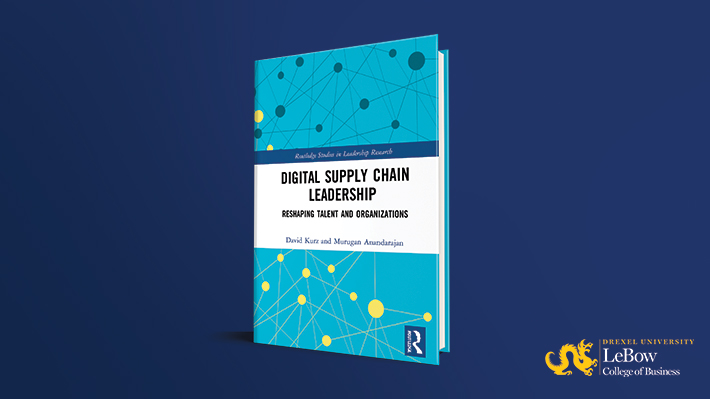
New Book by LeBow Faculty Addresses Digital Transformation in the Supply Chain Field
How do organizations lead the transformation to digital business in the midst of turmoil? That was the challenge facing two LeBow professors in 2020.
As David Kurz, EdD, associate clinical professor of management, and Murugan Anandarajan, PhD, professor of management information systems and interim associate dean of academic affairs and programs, collaborated on a book assessing the future of the supply chain field, the COVID-19 pandemic was reshaping everything from daily business operations to consumer purchasing behavior.
“The process of uncovering the audience and the need addressed by the book was a key developmental discussion we spent the most time on in the early stages,” Anandarajan said. “Our dialogue focused on the barriers leaders are facing when transforming to digital, and what kind of book would help them in the early stages of formulating their digital action plans. This exploration was key to developing the book.”
Their book, “Digital Supply Chain Leadership: Reshaping Talent and Organizations,” is published by Routledge and is available now. We talked with lead author Kurz about the impact he hopes this book will have and how it’s built to address both current and future issues the supply chain industry faces.
Q: The COVID-19 pandemic has obviously presented challenges for supply chains across the country and around the world. How does the guidance in this book match up with some of the changes companies have made as a result?
DK: The companies that are really performing well are already doing the things we recommend in the book. We’re the ones learning from digital-native companies, who are data-driven in their decision making, including their supply chains. For companies that are not digital natives, it’s a very different story: Legacy systems, processes and data have inhibited their ability to transform. Digital transformation is very daunting, and a lot of firms have said they’d rather delay that work because it’s too complex or there are organizational barriers, but COVID-19 has made that delay less tenable. There’s competition from new entrants that may not have these issues, and they’re going to take your customers away.
Q: How much of what you were able to include in the book reflects industry challenges of recent months?
DK: This book was written during the pandemic, so while the research took place prior, we developed the book and tied its frameworks to issues that leaders are currently facing. The pandemic made the demand for this type of book even clearer and made it seem even more urgent. The book is designed to help organizations that have realized the need to make these changes but don’t know where to start.
We went back to fundamental principles in supply chain: Who are your customers, what do you know about them and what do they need? We also tried to capture the use of technology, data and innovative business models that integrate those things. Sustained competitive advantage is the goal – we want to create hard-to-replicate capabilities, and in digital that usually means integrated capabilities that cut across functions. That’s where leadership comes in, because to execute one of these strategies takes courage and leadership acumen. Inspiring a supply chain leadership mindset means bringing together disparate functions in a more integrated way to deliver a business model that you couldn’t have done before.
Q: What skills or knowledge do students interested in pursuing careers in supply chain need to succeed?
DK: We felt there’s a need to equip our graduate students in supply chain not just with technical skills in problem solving but also the leadership and management aspects. We know it’s important for students to have a foundation in data analytics, but they also need to be able to think critically and foster strong decision-making skills, which is something I focus on, as well as skills in leadership, team building and collaboration. In order to transform a business, those are the skills you need. If you rely on technical, data-driven analytical approaches to change, that may not be enough to move the needle in organizations that are really struggling with change.
Q: What do you hope industry leaders might take away from this book’s content?
DK: There’s a tendency for firms in a crisis to deal with “the alligator closest to the canoe but miss the waterfall that’s coming.” I would hope they realize the time for implementing strategic change is now, and creating leaders and using data and technology is something that can’t wait until the storm is over.
What’s changed as a result of our current environment is there’s an expectation that supply chains may be measured in terms of more than just cost, such as exceeding customer expectations and growing the business. We need supply chain leaders that have a growth mindset for the firm instead of seeing supply chain as a back-office function, and they need a seat at the table when discussing business models and strategy. For a long time, Chief Technology Officers were viewed as the people that focused on hardware and software. Of course, now, in the digital age, technology is an integrated part of delivering customer value. That same evolution is about to happen for firms in the supply chain, and we’re trying to get them to at least consider that supply chain leaders in the future will be more involved in helping develop strategy as part of the executive team.


